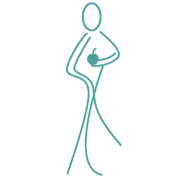The Golf Swing
The golf swing is a highly complex movement pattern that requires coordination of all the body’s joints and muscles along with timing and balance. Due to the length of the golf club even small variations in movement are amplified resulting in large changes in golf-head trajectory. For this reason even small dysfunctions in movement patterns can have large disturbances in performances. If one area of the body is not functioning optimally it can affect performance and lead to an increased risk of injury. Think about a wheel on a bike; often when a spoke becomes loose it will lead to extra stress being placed on other spokes in the wheel, which in turn will often break. If the mechanic replaces the spoke but does not make sure all the spokes are equally tensioned it won’t be long before spokes begin to snap again.
Osteopathic approach
One of the guiding principles of osteopathy is that we consider the body as a unit. What this means is we do not look at any one part of the body in isolation. For example a patient may present with low back pain; this may be the result of tight hip flexors or an immobile mid spine. When examining a golfer we always look at the whole kinetic chain involved in the golf swing.
Aims of osteopathic treatment for golfers
- Prevent injury
- Recover from existing injury
- Optimize performance
The neck (cervical spine)
The golfer needs good neck rotation and stability to enable good eye-to-ball contact, during the golf swing. A chin that pokes out two much will lead to excessive curves in the neck. This can limit movement and increase the risk of neck pain. Restrictions within individual joints will disturb the overall movement of the neck.
The upper and mid back (thoracic spine)
Good trunk rotation is a key part of the golf swing. In particular the thoracic spine (the section of the spine that has ribs attached) is responsible for the majority of the trunks overall movement. Restrictions here can lead to excessive strain being placed on the lower back and neck; this can shorten the length of the overall swing and reduce efficiency of the swing. Other joints may try to compensate for this lack of movement by becoming more mobile. This imbalance of hypo-mobile and hyper-mobile joints can affect the fluidity of the swing. In turn this can be detrimental to accuracy and consistency of shots played.
The lower back (lumbar spine)
This is one of the most common injury sites in golfers. The golf swing ends with extension of the lower back. Good control and strength of the abdominal muscles is required to prevent hypertension of the lower back which can cause disk and facet joint injuries.
The hips
Good rotation of the hips, in particular good internal rotation of the lead hip, is important in a good follow through of the swing. In fact if you are a golfer who keeps the lead foot planted during the follow through good internal rotation of the lead hip is absolutely vital. Restriction in this area will lead to extra strains and stresses being place on the lower back and on the lead knee making them vulnerable to injury.
The wrist
A common site of injury in golfers is the lead wrist, which requires good ulner and radial deviation, in other words good side-to-side movement towards the wrist and thumb. The muscles in this area also need good strength and control to prevent these movements from becoming excessive.
Physical restrictions (passive) versus functional control (active)
When assessing this movement of the trunk I will first examine and treat physical restriction. To do this I will ask the golfer to sit on the treatment couch and using my hands, place their torso into rotation. If this movement is good I will then ask them to stand and turn their trunk to both sides without moving their pelvis. Often a golfer with reduced physical movement is not able to actively rotate through their physical full range of motion under the control of their own muscles. This is what is known as poor functional control. If necessary I will then prescribe exercises to retrain the golfer’s ability to actively move through their full range. If a golfer has poor physical movement this must be addressed before functional movement can be rectified. Good functional activation of the trunk muscles facilitates better control during deceleration of the swing. If these muscles fail to control and absorb deceleration of movement excessive forces are transmitted into joints and ligaments making them more vulnerable to injury.
Some golfers find it difficult to avoid hunching the back during their stance phase. This slumped movement prevents full rotation of the spine during both the back and forward swing. With the appropriate cues the golfer is able to learn how to hold the spine in a neutral forward/backward position and increase the range of movement and power, and this lower the risk of injury.
Osteopathic treatment
Osteopaths use a hands on approach in treatment of injuries. We use a range of techniques including:
- Trigger point release
- Progressive stretching
- Muscle Energy Technique (MET) stretching
- Positional release
- Joint manipulation
- Joint articulation
- Soft tissue manipulation/massage
- Harmonics
Exercise prescription – strength, stretching, balance, proprioception (sense of position and movement), functional control, and core stability
As a golfer I should consider osteopathy if I:
- Wish to optimise biomechanical movement and functional control in order to improve my game
- Wish to prevent injury
- Am currently injury free but am prone to repeated injuries
- Wish to recover from injury
Barry McVeigh, Registered Osteopath
 Psychology
Psychology Osteopathy
Osteopathy Diet & Nutrition
Diet & Nutrition